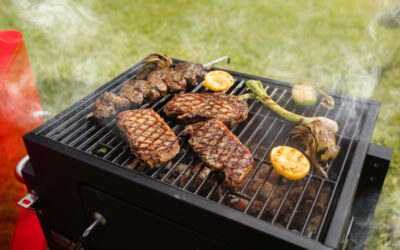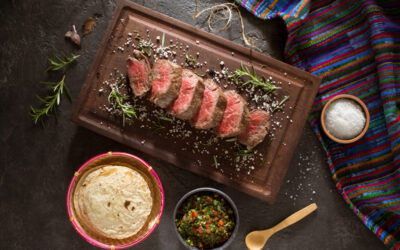

MARKET UPDATE
The past three weeks have brought about significantly smaller slaughter head counts with head counts on Saturday the primary source of change. In the past three weeks, we’ve seen two Saturdays with fed cattle head counts of 12,000 head each with last Saturday’s total just 7,000 head. These compare to the corresponding Saturdays a year ago that averaged 36,000 head each.
Carcass weights have become a more important factor in total beef tonnage lately. As seen in the table, steer weights are now 22 lb. lighter than a year ago. It’s redundant to continue to focus on winter weather impacts but this factor is key to the drop in weights. At the end of January, many cattle feeders in northern climates had shared that cattle had gained very little in the past 30 days.
The combination of smaller slaughter totals and lighter carcass weights across all cattle classes have pushed boxed beef values sharply higher. The quality spreads widened last week as the CAB cutout value increased more readily than Choice, with Select increasing at a smaller margin yet.
As we discussed in the previous Insider, the effect of smaller supplies in both cattle and boxed beef markets has a tendency to generate sharply higher spot market values. Realizing that the spot market trade volume is quite small during these periods, the net result is still strong in affecting the market direction.
Given the magnitude of last week’s advance in boxed beef values, it’s unsurprising that most cuts from the CAB carcass report moved higher. Notably, in the middle meats ribeyes made an abrupt turnaround to the upside after correcting 16% lower since the first of the year. Buyers looking for bargains on strip loins missed their chance back in December, as 0x1 strips have advanced from $7.80/lb. to $9.10/lb. wholesale since January 1. Tenderloins have priced sideways for three weeks but at $14.95/lb. wholesale they are record-high for this time. The current price of $14.95/lb. is $2.90/lb. higher than a year ago.
Chuck rolls and inside rounds made notable upward price moves last week and it’s projected that this will be the general direction into the spring. Ground beef prices have been a bit softer to steady with a similar upward price pattern in the near future weeks.
Cattle Library Contract Library Pilot Kicks Off
The USDA Cattle Contracts Library pilot program kicked off with the first report on January 7. The program’s intent is to enhance price transparency in the fed cattle trade as a provision of the Consolidated Appropriations Act, 2022. Individual packing plant locations harvesting no less than 5% of the total U.S.-fed cattle supply annually are required by law to submit contract information. According to the USDA, the provision encompasses 18 packing plant locations operated by four packing firms that represent a total of approximately 85% of the total fed cattle packing volume.
In 2022 about 70% of fed cattle sales were reported as either formula or forward contract.
A look at the weekly reports on record thus far reveals few surprises. Last week’s data shows that 75% of these contracts establish the base price through USDA reports, primarily the Nebraska, Kansas and Texas/Oklahoma regional reports. Another 10% use CME contracts to establish the base price, with 9% negotiating the base and the final 4% using the top of the market as the base. Confidentiality requirements result in the sum of these percentages falling short of 100%.
Of further interest, adjustments to the base price were applied to 70% of the contracts reported with the adjustment averaging $1.23/cwt. Base price adjustments of this type are a well-known feature of the market. The bottom quartile value of these adjustments was just $0.50/cwt. and the top quartile average was $2.00/cwt. applied to the base.
Contract specifications may be the topic in the library previously least understood by the greater cattle-producing industry. The specification list is too lengthy to detail here but the majority of the specs are relative to carcass grading and other carcass traits. The table displays the top 12 specifications ranked in order of prevalence.
Leading off the list, unsurprisingly, was the “Quality” spec with 88.76% of contracts featuring that component. With no further detail included, we’ll assume “Quality Grade” is the measure this refers to. Further down the list ranked sixth for prevalence is “Branded” (for which we’d assume “branded beef program”) with 49.44% of contracts including this spec. The Certified Angus Beef ® brand is the only brand listed in the detailed premiums and discounts pricing information.
While there are several styles of contracts represented in the library perhaps the take-home message is that there are fewer mysteries within the library than one may have thought. Carcass outcomes are widely emphasized in the contract mix and quality is the largest driver of premiums and discounts. This is very similar to what we see in the grid marketing arrangements offered more openly to feedyards.
There are many specification traits of importance, and it would be advantageous for cattlemen to take a closer look at the additional information. To access, go to https://mymarketnews.ams.usda.gov/filerepo/reports and type in the “Slug ID” number “3663.”
Read More CAB Insider
Progress, Not Complacency
Beef demand has been exceptional because of dramatic increases in consumer satisfaction for a few decades. Since taste ranks at the top of the list when it comes to what drives consumers to choose beef, we know where our figurative “bread is buttered.”
Cutout and Quality Strong
Summer weather has begun to set in with more regions of the country set to experience hotter temperatures. This means the traditional turning of consumer focus toward hamburgers and hot dogs rather than steaks, the spring favorite.
Onward with Quality
It’s been a quality-rich season in the fed cattle business with added days on feed and heavier weights continue to push quality grades higher.





